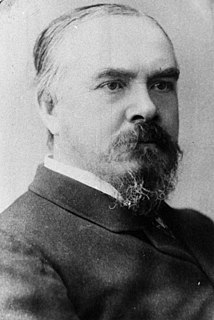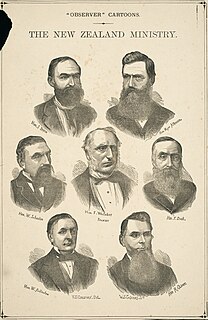
John Ballance was an Irish-born New Zealand politician who was the 14th Premier of New Zealand, from January 1891 to April 1893, the founder of the Liberal Party, and a Georgist. In 1891 he led his party to its first election victory, forming the first New Zealand government along party lines, but died in office three years later. Ballance supported votes for women. He also supported land reform, though at considerable cost to Māori.

Richard John Seddon was a New Zealand politician who served as the 15th Premier of New Zealand from 1893 until his death.

William Ferguson Massey, commonly known as Bill Massey, was a politician who served as the 19th Prime Minister of New Zealand from May 1912 to May 1925. He was the founding leader of the Reform Party, New Zealand's second organised political party, from 1909 until his death.

Sir Robert Stout was a New Zealand politician who was the 13th Premier of New Zealand on two occasions in the late 19th century, and later Chief Justice of New Zealand. He was the only person to hold both these offices. He was noted for his support of liberal causes such as women's suffrage, and for his strong belief that philosophy and theory should always triumph over political expediency.
This article gives an overview of historic liberalism in New Zealand. It is limited to liberal parties with substantial support, mainly proved by having had a representation in parliament.
The New Zealand Liberal Party was the first organised political party in New Zealand. It governed from 1891 until 1912. The Liberal strategy was to create a large class of small land-owning farmers who supported Liberal ideals, by buying large tracts of Māori land and selling it to small farmers on credit. The Liberal Government also established the basis of the later welfare state, with old age pensions, developed a system for settling industrial disputes, which was accepted by both employers and trade unions. In 1893 it extended voting rights to women, making New Zealand the first country in the world to enact universal female suffrage.
The Reform Party, formally the New Zealand Political Reform League, was New Zealand's second major political party, having been founded as a conservative response to the original Liberal Party. It was in government between 1912 and 1928, and later formed a coalition with the United Party, and then merged with United to form the modern National Party.

Sir Joseph George Ward, 1st Baronet, of Wellington, was a New Zealand politician who served as the 17th Prime Minister of New Zealand from 1906 to 1912 and from 1928 to 1930. He was a dominant figure in the Liberal and United ministries of the late 19th and early 20th centuries.

Sir William Hall-Jones was the 16th Prime Minister of New Zealand from June 1906 until August 1906.

The New Zealand general election of 1905 was held on Wednesday, 6 December in the general electorates, and on Wednesday, 20 December in the Māori electorates to elect a total of 80 MPs to the 16th session of the New Zealand Parliament. A total number of 412,702 voters turned out, with 396,657 voting in the European electorates.

The 19th New Zealand Parliament was a term of the New Zealand Parliament. It opened on 24 June 1915, following the 1914 election. It was dissolved on 27 November 1919 in preparation for 1919 election.
The New Liberal Party of New Zealand was a splinter group of the original Liberal Party. It was formed at a meeting in the Christchurch suburb of Papanui in June 1905 by two Liberal-aligned independents who sought a more "progressive" policy than that followed by the Liberal leader, Richard Seddon, and was similar to the Radical Party in 1896.

The 11th New Zealand Parliament was a term of the Parliament of New Zealand.

The 16th New Zealand Parliament was a term of the New Zealand Parliament. It was elected at the 1905 general election in December of that year.

The 18th New Zealand Parliament was a term of the New Zealand Parliament. It was elected at the 1911 general election in December of that year.

The New Zealand Liberal Party leadership election 1913 was held on 11 September to choose the next leader of the New Zealand Liberal Party. The election was won by Awarua MP and former party leader Joseph Ward.

The New Zealand Liberal Party leadership election 1906 was held to choose the next leader of the New Zealand Liberal Party. The election was won by Awarua MP and incumbent deputy leader Joseph Ward.
The New Zealand Liberal Party leadership election 1893 was held to decide the second leader of the New Zealand Liberal Party. The position went to Westland MP and incumbent deputy leader Richard Seddon.

Conservatism in New Zealand is related to its counterparts in other Western nations, but developed uniquely over time. Advocates followed a political ideology that emphasised the preservation of traditional beliefs, institutions and practices.

In April 1912 and July 1913, two "unity conferences" were held to discuss and determine the future of organised labour in New Zealand. The events mainly centred around the debate over whether industrial action or political activity should be the means of achieving the aims of workers and additionally to unite the "moderate" and "militant" factions within the labour movement. Whilst neither conference fully unified the labour movement, it laid a framework of co-operation that would later assist during the creation of the current New Zealand Labour Party in 1916.












